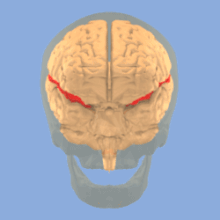This article needs additional citations for verification. (February 2019) |



In biological morphology and anatomy, a sulcus (pl.: sulci) is a furrow or fissure (Latin fissura, pl.: fissurae). It may be a groove, natural division, deep furrow, elongated cleft, or tear in the surface of a limb or an organ, most notably on the surface of the brain, but also in the lungs, certain muscles (including the heart), as well as in bones, and elsewhere. Many sulci are the product of a surface fold or junction, such as in the gums, where they fold around the neck of the tooth.
In invertebrate zoology, a sulcus is a fold, groove, or boundary, especially at the edges of sclerites or between segments.
In pollen, a grain that is grooved by a sulcus is termed sulcate.